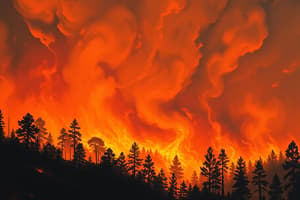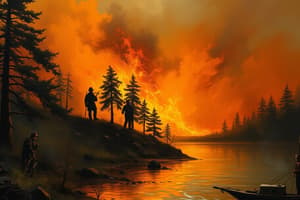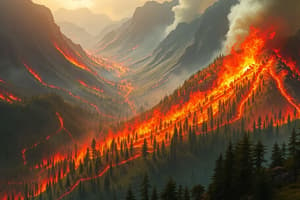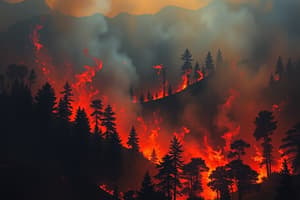Podcast
Questions and Answers
Fire requires the following three conditions:
Fire requires the following three conditions:
- fuel, heat, and lightning
- fuel, oxygen, and dry conditions
- fuel, oxygen, and heat (correct)
- oxygen, dry conditions and lightning
- oxygen, dry conditions, and heat
Which of the following best describes what happens during the preignition process in wildfire development?
Which of the following best describes what happens during the preignition process in wildfire development?
- Fuel is heated, it loses water and is ready to be ignited (correct)
- Gases cool and contract to produce fuel.
- Gases heat and expand into fuel.
- Fuel at the front of a fire is ignited
- Fuel gains carbon dioxide and is ready to burn.
Why are wildfires becoming more disastrous?
Why are wildfires becoming more disastrous?
- government resources for firefighting are insufficient
- more people are moving to areas at risk for fire hazards (correct)
- the frequency and severity of lightning storms is increasing
- the climate is getting drier as global temperatures rise
- past fire-supression techniques have increased the amount of fuel available
In Canada, the geographic area that is most at risk from forest fires is
In Canada, the geographic area that is most at risk from forest fires is
A fire is considered extinct when
A fire is considered extinct when
Which of the following factors most influence the, spread, intensity and form of a wildfire?
Which of the following factors most influence the, spread, intensity and form of a wildfire?
Presently in Canada most wildfires are started by:
Presently in Canada most wildfires are started by:
When combustion takes place
When combustion takes place
If you were a geologist, what evidence might you find (in rocks or sediments) that would indicate that wildfires had occurred in the past?
If you were a geologist, what evidence might you find (in rocks or sediments) that would indicate that wildfires had occurred in the past?
Which of the following factors affects the amount of shaking an area experiences during an earthquake?
Which of the following factors affects the amount of shaking an area experiences during an earthquake?
Hot fires that scorch dry, coarse soil may lead to
Hot fires that scorch dry, coarse soil may lead to
Flashcards
Preignition
Preignition
The process of heating fuel to the point where it releases flammable gases.
Surface Fire
Surface Fire
A fire that spreads through a layer of vegetation, such as grass, shrubs, or trees.
Ground Fire
Ground Fire
A hot fire that burns deep into the ground, consuming roots and soil.
Crown Fire
Crown Fire
Signup and view all the flashcards
Fire Regime
Fire Regime
Signup and view all the flashcards
Pyrolysis
Pyrolysis
Signup and view all the flashcards
Smoldering Combustion
Smoldering Combustion
Signup and view all the flashcards
Flaming Combustion
Flaming Combustion
Signup and view all the flashcards
Ignition
Ignition
Signup and view all the flashcards
Earthquake
Earthquake
Signup and view all the flashcards
Focus
Focus
Signup and view all the flashcards
Epicenter
Epicenter
Signup and view all the flashcards
Earthquake Magnitude
Earthquake Magnitude
Signup and view all the flashcards
Earthquake Intensity
Earthquake Intensity
Signup and view all the flashcards
Tectonic Event
Tectonic Event
Signup and view all the flashcards
Divergent Plate Boundary
Divergent Plate Boundary
Signup and view all the flashcards
Convergent Plate Boundary
Convergent Plate Boundary
Signup and view all the flashcards
Transform Plate Boundary
Transform Plate Boundary
Signup and view all the flashcards
Subduction Zone
Subduction Zone
Signup and view all the flashcards
Normal Fault
Normal Fault
Signup and view all the flashcards
Reverse Fault
Reverse Fault
Signup and view all the flashcards
Strike-Slip Fault
Strike-Slip Fault
Signup and view all the flashcards
Hydrologic Cycle
Hydrologic Cycle
Signup and view all the flashcards
Evaporation
Evaporation
Signup and view all the flashcards
Condensation
Condensation
Signup and view all the flashcards
Precipitation
Precipitation
Signup and view all the flashcards
Runoff
Runoff
Signup and view all the flashcards
Infiltration
Infiltration
Signup and view all the flashcards
Aquifer
Aquifer
Signup and view all the flashcards
Subsidence
Subsidence
Signup and view all the flashcards
Sinkhole
Sinkhole
Signup and view all the flashcards
Expansive Soil
Expansive Soil
Signup and view all the flashcards
Karst Topography
Karst Topography
Signup and view all the flashcards
Solution
Solution
Signup and view all the flashcards
Permafrost
Permafrost
Signup and view all the flashcards
Study Notes
Fire Science
- Fire requires three components: fuel, oxygen, and heat.
- Preignition involves heating fuel, causing water loss and readiness for ignition.
- Wildfires are becoming more disastrous because of increased fuel availability from past suppression techniques, drier climates (rising global temperatures), and more people living in fire-prone areas.
- Canada's boreal forest is the most fire-prone area.
- A fire is considered extinct when combustion stops, including smoldering.
- Wind heavily influences wildfire spread, intensity, and form.
- Most Canadian wildfires are started by humans.
- Ignition is the point where combustion begins.
- Charcoal is a geological sign of past wildfires.
- Factors affecting earthquake shaking include the distance from the focus, magnitude, and local geology.
- Hot fires can create a water-repellent layer in the soil, increasing the risk of landslides.
- Wildfire behavior is classified based on the fuel layer that allows spreading.
- Lightning is the most important condition for large wildfires over decades to centuries.
- Flaming combustion quickly consumes fuel, while smoldering combustion leaves unburned material.
- A fire regime describes the pattern of fire activity in an area.
- Wildfires release carbon dioxide, water vapor, heat, and light.
- Warmer, drier climates likely contributed to increased wildfires at the end of the Pleistocene epoch.
- Prolonged droughts and excessive fuel buildup were key factors in the severity of the 2003 and 2009 British Columbia fires.
- The natural burn policy in Yellowstone National Park revitalized park ecosystems.
Coastal Processes and Hazards
- Beaches on tectonically passive margins often have extensive sandy beaches.
- Wave fetch, duration, and wind velocity affect wave size.
- East Coast beaches in North America are generally wider and sandier than West Coast beaches due to their distance from convergent plate boundaries.
- Wave size is not influenced by water temperature.
- Hurricanes are named sequentially from a list of names for that year.
- Wave erosion is limited in the Arctic due to limited fetch due to sea ice.
- Hurricanes are a significant threat to the Atlantic coast of Canada.
- Winds around a low-pressure system in the Northern Hemisphere blow counter-clockwise.
- The worst hurricane to hit the East Coast of Canada since 1873 was Hurricane Hazel (1954), followed by Hurricane Juan (2003).
- Wave height is measured by the vertical distance from the wave trough to the crest.
- Forecasts for hurricanes use doppler radar, aircraft, weather satellites, and buoys.
- Littoral drift includes beach drift and longshore drift.
- Waves feel bottom when the water depth is half the wavelength.
- A tropical depression develops into a tropical storm when it develops a distinct central low-pressure zone.
- Barrier island formation requires littoral drift and wave refraction.
- Flying debris causes the most fatalities in hurricanes.
- The Saffir-Simpson scale classifies hurricanes based on wind speed.
- Hurricane risk in the US is increasing due to rising coastal population density.
- The Atlantic hurricane season is typically from June to November.
- Wave erosion is limited in the Arctic due to limited fetch due to sea ice.
- Waves break when they reach shallow water and their height rises.
- Wave period is measured by time between crests.
- Human activity like leveling dunes increases coastal vulnerability to erosion.
- Storm surge is not affected by the age of the storm.
- A hurricane is named when winds reach 63 km/hr.
- Most precipitation in a hurricane occurs in the eye wall.
- A Nor'easter is an extratropical cyclone.
- Storm surges are most influenced by the shape of the coastline.
- Steep rock shorelines are common along the British Columbia coast.
- Hurricane Hazel, an extratropical cyclone, caused 81 fatalities in Toronto.
- Breakwaters are hard stabilizations built to protect harbors.
- Bluff erosion in the Great Lakes is most severe when lake levels are high.
- The Pineapple Express is a flow of warm air that fuels winter extratropical cyclones in the Pacific.
- Hurricanes are least likely to occur in the Southeast Atlantic.
- Storm surge is a large increase in sea level by the action of a storm.
- A typhoon is a hurricane in the Western Pacific Ocean.
- Wave size is not influenced by water temperature.
- Hurricane forward speed is typically less than 27 km/hour.
- Sudden changes in shorelines on the west coast of Canada may be caused by earthquakes.
- Hurricanes are uncommon at the equator because of the lack of the Coriolis Effect.
- Plunging breakers occur when a wave encounters a steep beach.
- Hurricane Juan was a category 2 hurricane.
- Florida has the highest risk of hurricane strikes.
- Extratropical cyclones create strong winter storms.
- Glacio-isostatic subsidence may cause the disappearance of islands.
- The Saffir-Simpson scale ranks hurricanes by wind speed.
- Wave size increases with fetch, and duration of wind.
- Cyclones are characterized by intensity—measured by wind speed and atmospheric pressure.
- A hurricane warning means imminent evacuation for low-lying areas.
- Tropical cyclone development follows: disturbance, depression, storm, hurricane.
- Strong temperature gradients are needed for hurricane formation.
- The lowest risk of hurricanes is in British Columbia.
- Storm surges are rapid local rises in sea level.
- Rainbands are spiraling clouds around a hurricane.
- Tropical storms differ from depressions based on wind speed.
- Water depth significantly influences wave movement. A wave's period, height, and wavelength all influence wave movement, which is not affected by water temperature.
- Coastal erosion from cyclones negatively affects the environment by removing/eroding vegetation, sand, and structures along the coast.
- A tropical depression differs from a tropical disturbance with the presence of a distinct central low-pressure zone.
- Coastal flooding is a result of subsidence.
- Sinkholes are usually formed most likely during times when ground water levels are low.
- Normal fault earthquakes typically occur at divergent plate boundaries.
- Factors that cause land subsidence do not include the creation of frozen ground.
- Reconstruction of communities is usually not considered a proactive response to hazards.
Soil Science
- Expansive soils are characterized by clay minerals.
- Collapse sinkholes result from surface rock and soil falling into underground caves, whereas solutional sinkholes form by dissolution from bedrock surfaces.
- Geologists study earthquake waves to learn about the Earth's interior.
- The hydrologic cycle is driven by solar energy.
- Landfill sinkholes can cause pollutants to seep into groundwater.
- Soil originates from weathered rock.
- Soil grain sizes (smallest to largest): clay, silt, sand, gravel.
- Karst topography is characterized by sinkholes and underground caves.
- Subsidence is the sinking of the ground surface.
- Coastal flooding is sometimes a result of land subsidence.
- Sinkhole collapse is more likely when groundwater levels are low.
Studying That Suits You
Use AI to generate personalized quizzes and flashcards to suit your learning preferences.




